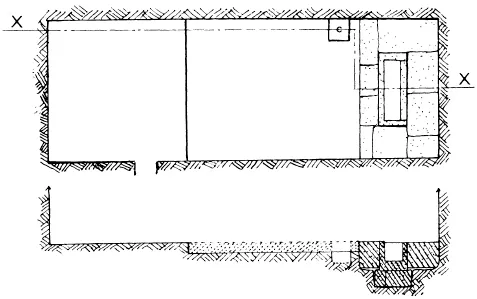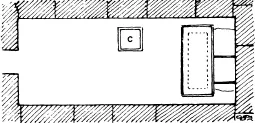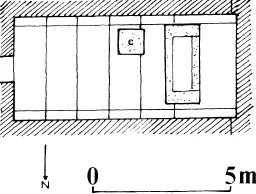
eBook - ePub
The Canopic Equipment Of The Kings of Egypt
Aidan Dodson
This is a test
Buch teilen
- 286 Seiten
- English
- ePUB (handyfreundlich)
- Über iOS und Android verfügbar
eBook - ePub
The Canopic Equipment Of The Kings of Egypt
Aidan Dodson
Angaben zum Buch
Buchvorschau
Inhaltsverzeichnis
Quellenangaben
Über dieses Buch
First published in 1994. The term 'Canopic', as applied to the containers employed by the Egyptians to contain the embalmed internal organs of the deceased, derives from a case of mistaken identity. The aims of this monograph are primarily archaeological and historical, to document all canopic equipment attributable to the kings of Egypt, and to discuss each element in its spatial and temporal context. Translations of all available texts are provided, but no attempt is made to discuss them from a detailed religious or philological standpoint.
Häufig gestellte Fragen
Wie kann ich mein Abo kündigen?
Gehe einfach zum Kontobereich in den Einstellungen und klicke auf „Abo kündigen“ – ganz einfach. Nachdem du gekündigt hast, bleibt deine Mitgliedschaft für den verbleibenden Abozeitraum, den du bereits bezahlt hast, aktiv. Mehr Informationen hier.
(Wie) Kann ich Bücher herunterladen?
Derzeit stehen all unsere auf Mobilgeräte reagierenden ePub-Bücher zum Download über die App zur Verfügung. Die meisten unserer PDFs stehen ebenfalls zum Download bereit; wir arbeiten daran, auch die übrigen PDFs zum Download anzubieten, bei denen dies aktuell noch nicht möglich ist. Weitere Informationen hier.
Welcher Unterschied besteht bei den Preisen zwischen den Aboplänen?
Mit beiden Aboplänen erhältst du vollen Zugang zur Bibliothek und allen Funktionen von Perlego. Die einzigen Unterschiede bestehen im Preis und dem Abozeitraum: Mit dem Jahresabo sparst du auf 12 Monate gerechnet im Vergleich zum Monatsabo rund 30 %.
Was ist Perlego?
Wir sind ein Online-Abodienst für Lehrbücher, bei dem du für weniger als den Preis eines einzelnen Buches pro Monat Zugang zu einer ganzen Online-Bibliothek erhältst. Mit über 1 Million Büchern zu über 1.000 verschiedenen Themen haben wir bestimmt alles, was du brauchst! Weitere Informationen hier.
Unterstützt Perlego Text-zu-Sprache?
Achte auf das Symbol zum Vorlesen in deinem nächsten Buch, um zu sehen, ob du es dir auch anhören kannst. Bei diesem Tool wird dir Text laut vorgelesen, wobei der Text beim Vorlesen auch grafisch hervorgehoben wird. Du kannst das Vorlesen jederzeit anhalten, beschleunigen und verlangsamen. Weitere Informationen hier.
Ist The Canopic Equipment Of The Kings of Egypt als Online-PDF/ePub verfügbar?
Ja, du hast Zugang zu The Canopic Equipment Of The Kings of Egypt von Aidan Dodson im PDF- und/oder ePub-Format sowie zu anderen beliebten Büchern aus History & Ancient History. Aus unserem Katalog stehen dir über 1 Million Bücher zur Verfügung.
Information
Part One
CHAPTER ONE
THE OLD KINGDOM
THE earliest surviving evidence for the artificial preservation of the dead body in Egypt dates to the Archaic Period.1 While it is probable that the removal of the internal organs played a major rôle in this from the outset, unequivocal evidence for their separate preservation is not found until the time of Kheops.2 However, architectural arrangements that appear to have been intended to accommodate wooden canopic chests may be identified in certain Second/Third Dynasty tombs at Saqqara and other sites.3
None of the Archaic Period royal tombs at Abydos4 seems to have preserved any evidence relating to canopiec, but their devastated condition means that no realistic conclusions can be drawn from this. The great complex of Djoser, on the other hand, possesses a number of architectural features that could be regarded as the location of possible canopic installations.
One particularly interesting suggestion is that one of each of the pairs of calcite sarcophagi which had lain in Galleries I-V below the east side of the Step Pyramid was intended for canopic use.5 The argumentation invokes the four allegedly canopic jars found in one of two calcite sarcophagi, identical to those under the pyramid, found at Dahshur inside the enclosure of Sesostris III.6 However, it seems most probable that the tomb in which they were found dates to the Middle Kingdom, their reuse there making them of no value in the present discussion.7
Most speculation has, however, centred on the South Tomb.8 This structure, built into the southern enclosure wall of the temenos, duplicates the main features of the Step Pyramid substructure on a smaller scale,9 with a burial chamber generally felt as being, at 160 cm square, too small to contain a body.10 In its position, south of the main tomb, and in the relative scale of the substructure, the mastaba-form South Tomb parallels later subsidiary pyramids. The first is found at Meidum at the end of the Third Dynasty, and the last in Twelfth Dynasty complex of Sesostris I at Lisht. While one cannot be certain in the matter, it seems reasonable to assume that the South Tomb is the prototype for these later structures. Accordingly, they ought to shed some light on the purpose of the earlier monument.
Unfortunately, the subsidiary pyramids themselves have provided little or no evidence on which to base an assessment of their purpose.11 Nevertheless, it is quite clear that they were not intended to house the viscera, given that canopic chests lay within the burial chambers of many main pyramids possessing subsidiaries, beginning with Khephren (q.v.).12
An alternative location for canopiecs might be sought amongst the great complex of passages that surround the burial chamber of the Step Pyramid itself, but none appears to have a location or form that would suggest that they were intended to hold Djoser’s viscera. Perhaps any canopic packages were placed alongside the mummy within the king’s rather unusual sepulchral chamber, whose form does not admit the use of a separate sarcophagus.13
The substructure of the pyramid of the Horus Sekhemkhet, Djoser’s probable successor, contained an empty sarcophagus, the meaning of which has been much discussed. In the burial chamber, tall niches exist both south-east and south-west of the sarcophagus;14 although no remains were found, one of these might have been intended to be canopic.
The Layer Pyramid at Zawiyet el-Aryan15 is normally placed directly after that of Sekhemkhet, and attributed to the Horus Khaba.16 Its substructure does not seem to have included potential canopic elements, nor does that of the Unfinished Pyramid at the same site.17
The same is true for what seem to have been the last two pyramids of the dynasty.18 The Brick Pyramid at Abu Roash19 has a simple, square, burial chamber, while the rectangular apartment of the pyramid of Meidum20 lacks any trace of arrangements for a sarcophagus/coffin or canopic chest; two 2.5 metre square niches lie in the approach corridor, but their number and location, north of the burial chamber, argue against any canopic rôle.21
Following the uncertainties of the Third Dynasty, tombs spanning its end and the beginning of the Fourth contain features that can be identified as canopic with some confidence: in a series of private tombs at Meidum niches occur at a high level in the south walls of a number of sepulchral chambers, in most cases, including those of Nefermaet and Rehotpe, at the eastern end.22 This position in the south-eastern corner of the burial chamber becomes the standard location of canopic installations in the slightly later Fourth Dynasty private tombs at Giza. These commonly comprise rectangular pits or wall-recesses, closed by limestone slabs, the pits occurring rather more frequently.23 No traces survive of the putative inner containers.
The most important evidence for the preservation of the viscera, and the earliest unequivocal item of canopic equipment, is the calcite chest of Queen Hetepheres, from Giza G7000X (plate la),24 which still contained the remains of apparent canopic packages. These lay at the bottom of each of the chest’s four square compartments, wrapped in linen and immersed in a 3% natron solution.25 The closed box, around which a sealed cord was passed, lay in a niche, cut at ceiling level at the south end of the west wall of the burial chamber.26
The developed form of Hetepheres’ stone chest might suggest some previous evolution, but no earlier example is extant. Indeed, chests carved from single blocks are otherwise known to begin in the Fifth Dynasty.27 During the Fourth Dynasty we have a handful of chests built from slabs which are, however, more in the nature of upward extensions of floor cavities.28 Canopic jars, in stone or pottery, make their appearance at the very end of the Fourth Dynasty. The earliest examples are also from the funerary outfit of a queen, in this case Meresankh III.29

FIGURE 1a. Plan and section of burial chamber of Giza GII (Khephren).

FIGURE 1b. Plan of burial chamber of S.Saqqara L.XXXVII (Isesi).

FIGURE 1c. Plan of burial chamber of Saqqara L. XXX (Teti).
Given that his wife possessed a canopic chest, one might have expected some form of box in the tomb of King Seneferu. However, nothing survives in the Northern Stone Pyramid at Dahshur, where he was very probably buried,30 although a built sarcophagus and/or box may have been obliterated when the whole floor of the burial chamber was destroyed in antiquity.31 Such a box is to be found in the floor of the sepulchral chamber of the Second Pyramid of Giza (Cat. 1); it is cut hard against the south wall of the chamber, south-east of the sarcophagus (plate Ib, figure la). The lower part is cut from the bed-rock, the upper half formed out of the (now missing) limestone paving of the room. On the basis of private parallels, it is unlikely that any further stone chest lay within the cavity. In all probability, the king’s viscera were housed within a wooden container.32
Such an installation cannot be identified in the burial chambers of Kheops and Mykerinos, nor any other feature that could be interpreted as canopic.33 It has been suggested that no cavity was sunk in these pyramids because of the granite paving of their sepulchral chambers, in contrast to Khephren’s limestone.34 Of the other two certain Fourth Dynasty kings’ tombs, the burial chamber of Djedefre’s Abu Roash monument has never been properly investigated. The floor of the tomb chamber of Shepseskaf’s Mastabat Fara’un was removed in antiquity.35 With it may have gone a built chest of the kind found in the Second Pyramid and the Giza private tombs noted above.
It is distinctly unfortunate that the sepulchral apartments of the pyramids of the first part of the Fifth Dynasty are either incompletely examined (Userkaf,36 Menkauhor37), totally devastated (Abusir pyramids of Sahure, Kakai, Neferefre, Niuserre38) or uncertainly identified (Shepseskare?39), so that it is not possible to comment on the canopic arrangements adopted therein. The earliest example available for examination is that of Isesi, which is a cavity sunk into the three courses of limestone blocks that form the flooring of the burial chamber (Cat. 2). Its position, directly opposite the southern end of the eastern face of the sarcophagus, is that employed for the rest of the Old Kingdom and differs only marginally from that ...